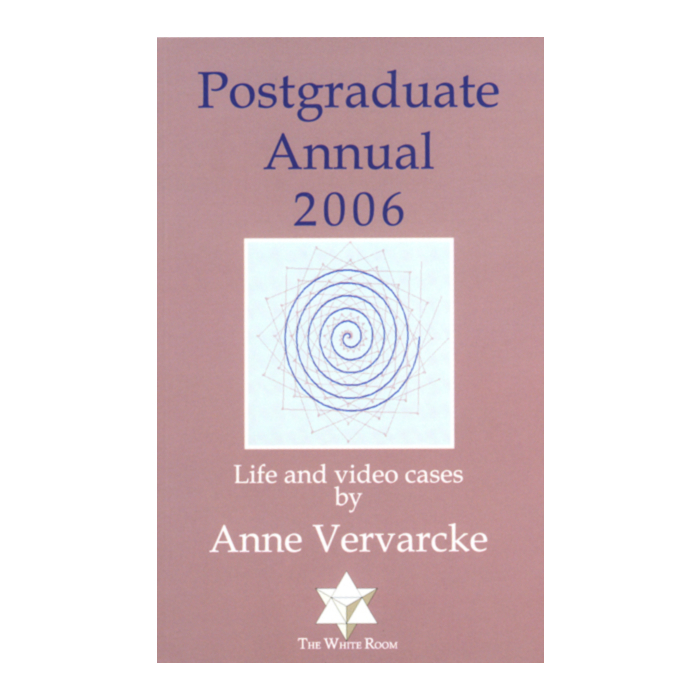OUT OF PRINT: Post Graduate Annual 2006
Delen op sociale media
The first Post Graduate Annual compiles all the life and video cases treated since the start in February 2005. Besides a condense introduction of the method that is followed, the main part of the book consists the detailed report of the cases and the analysis that led to the prescribed remedies. Although a crucial part of the homeopathic treatment is the long term management, the cases speak for themselves. As homeopaths we know the patient speaks the true language of nature, as Hahnemann puts it in his Organon; our mission is to be the silent witness and to understand. Then we can give the simillimum and restore the sick to health.
Excerpts:
P. 14: The individual shading of the world however emanates from the vital level. In a homeopathic anamnesis we try to infiltrate to this level and since this has to happen with words, we go via the mental level by necessity. It is specific to the homeopathic method to try to understand the symbol of the disturbance and to find the symbol that is the most similar.
The difficulty often lies in the “noise” psychology causes on this level. We all possess a human psyche that in analogy with the physical body can be ‘healthy’ or ‘disturbed’ and will bear the traces of the milieu in the broadest meaning of the word. This includes ‘education’, cultural and social forming and all psychological experiences that can be associated with that. The psyche has its own logic: experiences from early childhood will have predictable consequences in adulthood. This is not a basis for a prescription. Perhaps this is the hardest part for the homeopath: to understand what, on this level, is general and what is individual, read: uncommon, rare and peculiar.
Even though the idea exists that newborn babies are almost like a “tabula rasa”, and that they are shaped by their environment, it is possible for anyone to observe that two children from the same parents can be very different, just like people with similar experiences can develop into different individuals. Based on this, we can conclude that there is an innate tendency, that is at least as important and maybe more important in becoming who we are, than the environment.
Using a witticism we can say that the environment can determine whether a carrot seed will grow into a beautiful, big, tasty carrot or into a crooked, small worm eaten one, but it’s absolutely certain that it will never be cultivated into a cabbage.
During consultation we should therefore look for the characteristics that are embedded into the seed. This is the vital level.
P. 18:…It is a great help for homeopathy to consider illness, the disturbance as a symbolic disturbance, a distortion in which the deepest sensations are disturbed by a feeling of a lack or loss, a fight or some sort of unpleasant or painful sensation that colors the experience.
Illness IS a distortion of reality. Everything is unconditionally good and perfect, including us, but we experience reality as dualistic and conditional. We all do that in our own individualistic way, no two people do it the same way, and the lens through which we perceive the world has a specific pattern. To find the homeopathic simillimum is the job of the homeopath. The similar remedy can adjust the distortion of the lens: the image becomes focused, reality clear; we remember who we really are and the result is inner peace and harmony.
P. 23: A patient may have the impression, from popularized books on homeopathy that we want to learn about his personality. This is not the case. The personality is the totality of his talents, education, psychological state and experiences in fact helps grown-ups to hide precisely those things that are difficult, unpleasant or impossible for him. We look for these qualities that surpass the personality, which subconsciously are ‘poison’ to the patient, but which can be transformed into real qualities, and become a potion that brings balance and harmony in a unique way.
Do we choose between the ocean or land, between animal or plant, between sun or moon, between day and night? All these things are part of Planet Earth, all together the form the total beauty and particularity of one single organism. In the same way all our organs and body cells form our whole body: one is not better or worse, nor more evolved than the other: the cells of the liver do not have the ambition to become brain cells. Each one has its precise and necessary qualities, particularities and function in the whole.
When all energy and effort is directed to one single common cause, the whole harmonizes in optimal cooperation and coherence.
| ISBN | 9789081001731 |
|---|---|
| Auteur | Anne Vervarcke |
| Type | Paperback |
| Taal | English |
| Publicatiedatum | 2010 |
| Pagina's | 276 |
| Uitgever | The White Room |

